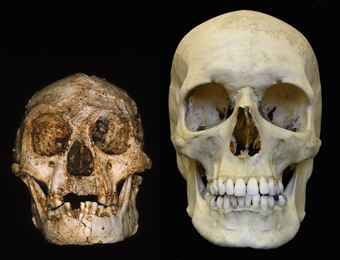- Home
- /
- UAlbany Faculty News
- /
- Release
- /
UAlbany Anthropologist's "Hobbit Research" is one of Top 100 Science Stories of 2008
Discover magazine cites study of a mysterious skeleton that has scientists asking if it's human or not
Contact(s): Catherine Herman (518) 956-8150
 |
Anthropologist Adam Gordon studied the size of the face and skull and other remains to determine that the hobbit was a distinct species of hominid (Photo Peter Brown, University of New England) |
ALBANY, N.Y. (December 22, 2008) -- University at Albany anthropologist Adam D. Gordon is a key investigator in one of the 100 best science stories of 2008, according to Discover magazine.
In March of this year Gordon published, with then-colleagues at George Washington University, a comparative study in the Proceedings of the National Academy of Sciences centering on an ancient skeleton discovered in 2004 on the island of Flores, Indonesia. The 18,000-year-old skeleton, which came to be known as the hobbit due to its chimp-sized brain, diminutive stature, and unexpectedly large feet, was given the new species name Homo floresiensis. Its discoverers argued that it was a small-bodied, small-brained descendant of Homo erectus, a species that preceded modern day Homo sapiens. Gordon studied the size of the face and skull and other remains to determine that the hobbit was a distinct species of hominid, descended from an even older species known as Homo habilis, which inhabited and then disappeared from Africa some 1.8 million years ago. The hobbit appears to have inhabited Indonesian islands 90,000-12,000 years ago.
In the January 2009 article "#85: Smackdown Over Ancient 'Hobbit' Continues " Discover notes that, according to Gordon, the skull of the hobbit was well outside the range of modern human variation.
"What's fascinating about this is the study suggests that a distinct lineage of humans, very different from our own, shared the planet with us for almost two million years, from the time our ancestors first left Africa until modern humans first populated the Americas," said Gordon.
Discover also cites the studies of other hobbit researchers, including paleoanthropologist William Jungers of Stony Brook University in New York, and Penn State evolutionary biologist Robert B. Eckhardt.
"Dr. Gordon and his collaborators' research is exciting because it helps put to rest a recent controversy in the scientific community about whether the 'hobbit' represents a different species that co-existed with modern humans or was a human born with microcephalia," said Dean Edelgard Wulfert of the College of Arts and Sciences.
The University at Albany Department of Anthropology pursues the study of fundamental humanness through teaching and research in the subdisciplines of archaeology, biological anthropology, cultural anthropology, and linguistic anthropology.
![]() For more news, subscribe to UAlbany's RSS headline feeds
For more news, subscribe to UAlbany's RSS headline feeds
Educationally and culturally, the University at Albany-SUNY puts "The World Within Reach" for its 18,000 students. An internationally recognized research university with 58 undergraduate majors and 128 graduate degree programs, UAlbany is a leader among all New York State colleges and universities in such diverse fields as public policy, nanotechnology and criminal justice. With a curriculum enhanced by 300 study-abroad opportunities, UAlbany launches great careers. For more information about this globally ranked University, visit www.albany.edu. For UAlbany's extensive roster of faculty experts, visit www.albany.edu/news/experts.shtml.


